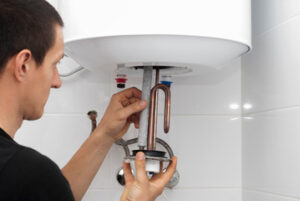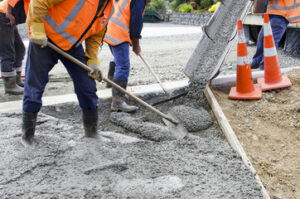Water heaters are central to many of our daily tasks, from showering to washing dishes. But when they break down, it can be difficult to know what to do next.

If you’re experiencing hot water troubles, start by ensuring the circuit breaker or high-temperature cutoff isn’t tripped. Then, try relighting the pilot light (but only after following safety instructions). You can also drain the tank and flush it to remove sediment. Contact Water Heater Repair Tampa for professional help.
The heating elements on an electric water heater, especially older ones, can corrode over time and need to be replaced. When one or both of them go bad, you’ll experience insufficient hot water from the faucets. The water in the tank will also be dirty because it will contain sediment that has accumulated over time. Fortunately, the replacement process is simple and quick once you have the right tools.
Turn Off Power and Drain the Tank
First, turn off the water heater power by turning off the circuit breaker at the breaker box. Then, run a garden hose from the drain valve on the bottom of the water heater to a floor drain or bucket. Next, open the drain valve and drain the water from the tank.
Once the tank is empty, close the drain valve. Then, remove the access panels that cover the heating elements. Use a socket wrench to remove the old element. Be sure to use a non-contact circuit tester to ensure the element has no power before loosening the terminal screws and disconnecting the circuit wires.
The upper and lower heating elements are threaded in with a gasket behind the flange on the front of the tank. Most of the time, the lower element goes first, because it’s more exposed to sediment buildup. It’s also typically cheaper than the upper one, so it makes sense to buy two at the same time and cut down on future repair costs.
When installing the new element, coat both sides of the new gasket with pipe-joint compound. Slide the gasket over the new element and screw it in place. Be careful not to over-tighten, which can result in leaking and water damage. Once you’ve installed the new element, connect the black and white circuit wires to each of the terminal screws on the element. Once the element is secure, you can fold down the insulation and screw the access panel back in place over it. Reconnect the water supply valve and open a hot water faucet to start refilling the tank.
Thermostat Replacement
The thermostat on your car is responsible for regulating the amount of coolant that runs through your engine so it doesn’t overheat. If your radiator hoses are leaking fluid or the temperature gauge on your engine is constantly rising, it’s time to replace your thermostat.
The good news is that it’s pretty easy to do and you can save yourself the cost of a professional repair service by doing it yourself. Just make sure you turn off the power and water supply before you start. You’ll also want to have a bucket nearby to catch the fluid that will flow when you loosen the bolts holding the thermostat housing in place. Drain the old fluid into a clean two-gallon bucket and pour it back into your radiator when you’re finished.
Sometimes, your water heater will stop working exactly when you need it most. If you’re in the middle of a shower or washing dishes and it suddenly goes cold, that’s a sure sign that something is wrong with your heater. You can try a few things to troubleshoot the problem yourself, like checking if it’s a tripped breaker or blown fuse. If you’re unable to find the cause of the problem, it’s definitely time to call a plumber for more advanced troubleshooting.
It may be possible that your water heater is simply a little undersized for the size of your home or family, which could cause problems with rumbling or gurgling noises. If the problem isn’t caused by a mechanical issue, it might be best to upgrade your tank to a larger size.
If your water heater has a strange smell or discolored water coming out of the faucets, it’s likely a sign that it is rusting inside. This can be a serious health hazard, so you should contact a professional water heater repair company as soon as possible.
It’s a good idea to drain your tank on a regular basis to prevent sediment buildup. If you’re unsure how to do this, or would prefer not to deal with the hassle, you can always call Oliver for a hot water heater flush. We’ll figure out the problem and get it fixed fast.
Dip Tube Replacement
No matter your water heater’s age, a dip tube is important to a good supply of hot water. It’s a long plastic piece that fits into the cold water inlet of the tank and stops about eight inches above the bottom of the tank. The purpose of the dip tube is to keep cold water from entering the tank until the gas burner or primary electric heating element is able to heat it up. The dip tube also keeps cold water from mixing with the hot water coming out of your hot water heater. A faulty dip tube leads to lukewarm water from your faucets, and it may lead to rust in the bottom of the water heater.
A dip tube can be replaced as part of a Water Heater Repair. This is a relatively simple job that can be done at home with some common tools. The first step is to shut off the circuit breaker that supplies power to your water heater. Then, disconnect the cold water inlet valve. After the water heater is completely drained (you can help this along by opening a few hot water faucets in your house), you should be able to see a small amount of plastic flakes floating in the bottom of the tank.
You can then disconnect the drain valve on the bottom of the tank and connect a garden hose to it. Allow the tank to drain thoroughly, and you’ll be ready to replace the dip tube. Make sure that you use a dip tube that is made of cross-link polyethylene, as this is more durable than other types of plastic tubing. After the old dip tube is removed, simply insert the new one into the inlet and drain line connection and tighten it.
This is a relatively easy job for a homeowner, but you should always contact a professional when dealing with gas water heaters. There are real dangers associated with playing with a gas water heater without the proper knowledge, experience and equipment.
Pressure Valve Replacement
The pressure-relief valve is an often-overlooked but important safety feature on a water heater. It releases excess hot water when the pressure in the tank reaches dangerous levels, mitigating the potential of an explosion or a burst that can flood your home.
The PRV works by opening whenever the temperature or pressure in the water heater reaches its preset limit—usually 150 psi and 210 degrees Fahrenheit. It’s an important part of your home’s plumbing system, but like all parts, it will eventually wear out. If your PRV has worn springs, a gummed-up drain valve, or is experiencing corrosion, it will need to be replaced. The type of repair kit you need depends on the material your pipes and valve are made from, such as PVC, bronze, brass or copper.
In addition to checking the pressure-relief valve for damage, you should also test it periodically to ensure it’s functioning properly. Start by positioning a bucket underneath the valve to catch any released hot water. Then, while wearing safety goggles and rubber gloves to reduce scalding, turn the valve switch to the on position. If it’s working correctly, you should hear and see water gurgling from the drain pipe.
If you don’t have a water pressure reducing valve installed in your home, we recommend having one installed as soon as possible. Water pressure that is too high can cause appliance, faucet and fixture damage as well as waste energy. A PRV will prevent unnecessary strain on your plumbing system and eliminate that annoying screching sound you sometimes get with household appliances when using them.








